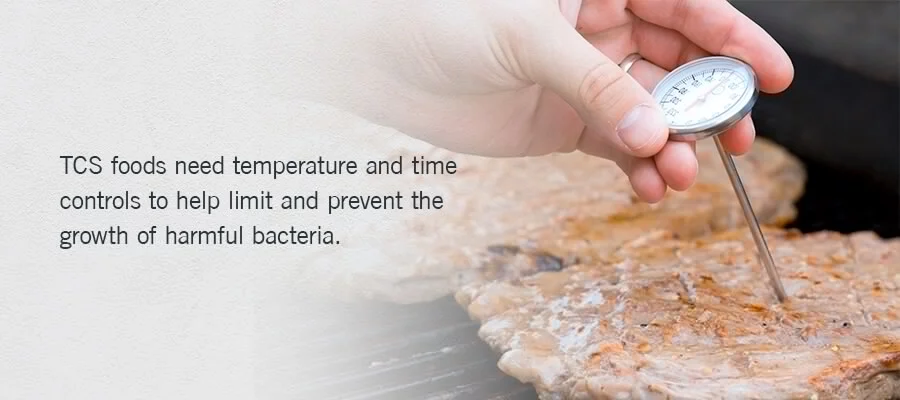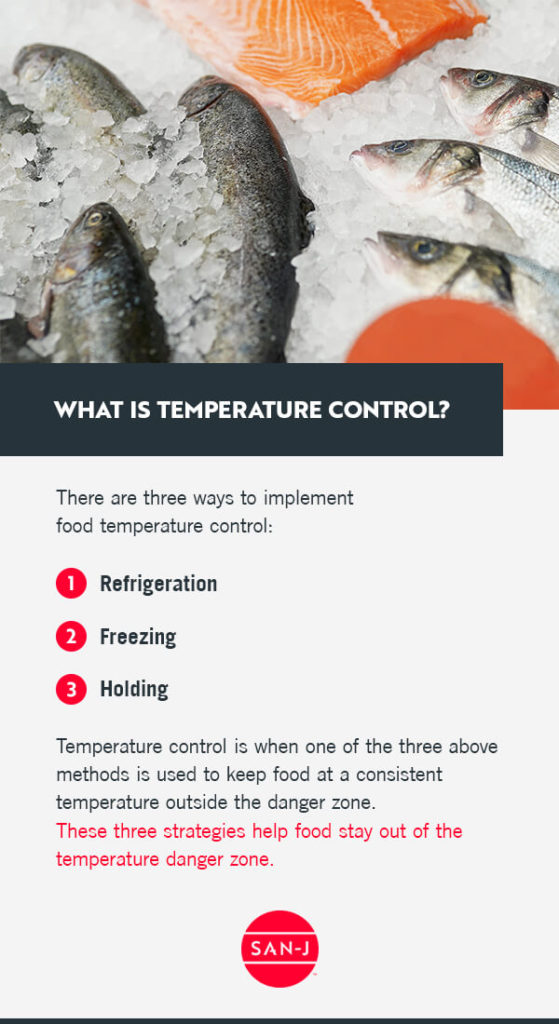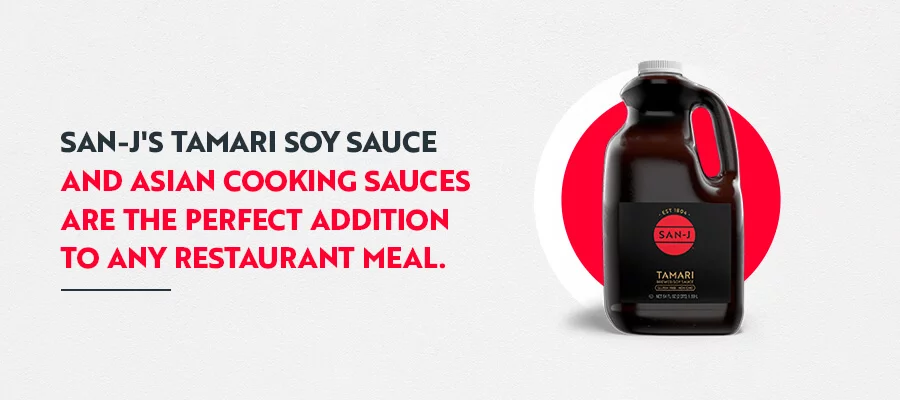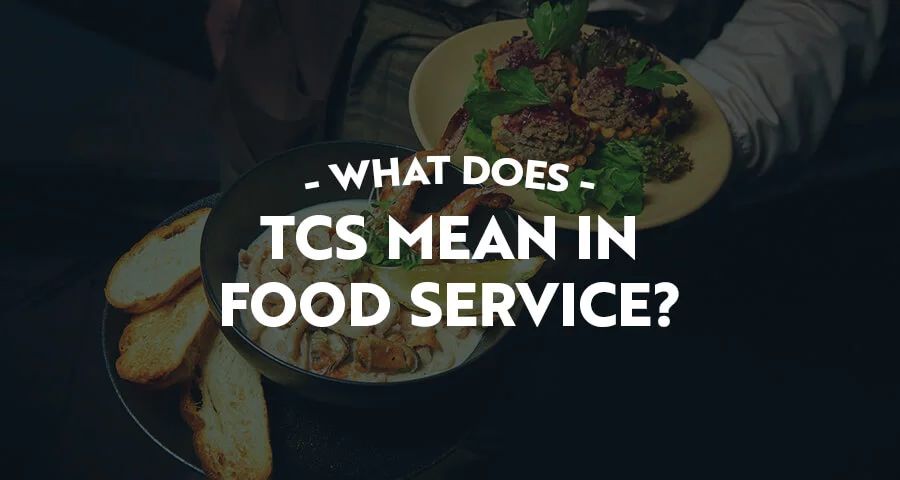Providing delicious food to customers is a rewarding experience for any food service worker. However, with so many different ingredients and cook times, keeping track of food so it stays fresh and healthy is essential. You need to prepare and store food carefully to ensure illness-causing bacteria aren’t growing inside.
Certain foods need temperature and time controls to prevent bacteria growth on their surfaces. Too much time or too moderate a temperature, and these foods become breeding grounds for bacteria. Learn more about TCS food safety and what it means for food service with this article.
Table of Contents
- What Does TCS (Time/Temperature Control for Safety Food) Mean?
- What Factors Determine if a Food Is TCS?
- How Can TCS Food Be Dangerous?
- What TCS Food Means for Food Service
- What Are the Temperature Danger Zones?
- Thawing Foods
- Warming Foods
- Cooling Foods
- How Food Service Can Keep TCS Foods Safe
- Check out Our Food Service Products

What Does TCS (Time/Temperature Control for Safety Food) Mean?
TCS stands for Temperature Control for Safety. Depending on various factors, some foods are more likely to encourage the growth of bacteria that can cause sickness if consumed. These foods are known as Time/Temperature Control for Safety (TCS) foods.
TCS foods need temperature and time controls to help limit and prevent the growth of harmful bacteria. Controlling for time and temperature means limiting the amount of time TCS foods are at bacteria-friendly temperatures and regularly monitoring temperatures to prevent encouraging bacteria growth. TCS foods need airtight storage in refrigerators or freezers, or they need to be fully heated and then kept at 135 degrees Fahrenheit to keep bacteria from growing in the food.
Some examples of TCS food are:
- Fish and shellfish
- Eggs
- Dairy
- Meat products
- Cooked vegetables
- Cut garlic in oil
- Custard or cream
- Raw sprouts
- Potato dishes
- Sliced tomatoes and melons
- Protein-rich plants
- Cut leafy greens
Not all foods are TCS foods. Some dry goods are low enough in their acid or moisture content that storing them at room temperature is no problem. Some non-TCS foods include:
- Bread
- Chips
- Candy
- Dried beans
- Uncooked rice
- Powdered milk
Lots of foods aren’t considered TCS foods. They’re often prepackaged, uncooked, dry or processed in some form. You don’t have to worry about bacteria growing on these foods quickly — they can often be left out during the day with little issue.
Even foods that aren’t considered TCS foods can still contain safety hazards if consumed. Combination products — foods with multiple non-TCS or TCS foods — are assumed to be TCS foods unless proven otherwise and should be handled carefully. Under the right conditions, bacteria will quickly multiply. Eating improperly stored food increases your customers’ risk of illness, especially if they’re eating a TCS food.
What Factors Determine if a Food Is TCS?
There are five factors that determine if a food is considered a TCS food. Some foods have protective rinds or skins and aren’t TCS foods until those protections are removed. With foods that meet these factors, you must take extra steps to ensure the safety of anyone consuming that food. The five factors that determine TCS food status are:
- Acidity or pH
- Water or moisture content
- Moisture and acidity interaction
- Heat treatment
- Packaging
These five factors make foods perfect for promoting bacteria growth. The key to TCS food safety is working to limit these factors so bacteria have a more challenging time growing in food. When bacteria are given the right amount of moisture at the right temperatures for extended periods, food will quickly become full of bacteria. This growth will increase the odds of consumers becoming sick when they eat poorly controlled TCS foods.
How Can TCS Food Be Dangerous?
Bacteria can cause severe illness when consumed. Bacteria need three conditions to grow — warmth, moisture and food. When bacteria spread and multiply, they can quickly make food unsafe for eating. TCS foods have the moisture and food needed for bacteria growth — add the right temperature and time conditions, and illness-causing bacteria will quickly spread.
Time is an essential part of bacteria growth. The longer food is allowed to sit in bacteria-growing conditions, the more bacteria will multiply on the food. Once bacteria have moisture, warmth and food, they can double their numbers every 20 minutes. After sitting for four hours, most TCS foods will have enough bacteria that they can make someone sick.
There are three main ways foodborne illnesses can result from TCS food:
- Food isn’t cooked properly
- Food isn’t reheated or cooked to bacteria-killing temperatures
- Raw or cooked foods aren’t stored at the required temperatures.
Without proper cooking, reheating, thawing and storage, foods can quickly become perfect environments for illness-causing bacteria. Once bacteria-filled food is consumed, people can experience food poisoning — symptoms include vomiting, nausea, diarrhea and cramping.
What TCS Food Means for Food Service
Many TCS foods are used in food service — this means that food service workers have to take extra steps to ensure anything being served is safe to eat. With so many foods requiring temperature and time controls, people in food service have to constantly monitor the preparation, cooking, serving and reheating of TCS foods to prevent the growth of bacteria.
Since people in food service are constantly working with TCS foods, they need to monitor their inventory and stay alert for potential bacteria-encouraging situations or contaminations. Not only is this required by the government, but it’s also key to preparing and serving high-quality, delicious food to customers.
TCS foods should be stored appropriately and cooked to eliminate illness-causing bacteria. This requirement means food service facilities need proper, functioning cold storage, whether that’s refrigerators and freezers or larger walk-ins. These facilities also need functioning cooking equipment to heat TCS foods to the correct temperatures.
Food service workers should use time and temperature controls to protect the food and consumers. An essential part of this is not letting food sit in the temperature danger zone for any longer than necessary. The more time food is sitting in temperatures that promote bacteria growth, the more bacteria can multiply and contaminate food.
What Are the Temperature Danger Zones?
Temperature is an important factor in bacteria growth. If foods sit at 41 to 135 degrees Fahrenheit for too long, bacteria can grow and multiply much more quickly. This temperature range from 41 to 135 degrees Fahrenheit is known as the temperature danger zone. TCS foods need to avoid this range or be moved through the temperature danger zone quickly so bacteria aren’t given a chance to thrive.

What Is Temperature Control?
There are three ways to implement food temperature control:
- Refrigeration
- Freezing
- Holding
Temperature control is when one of the three above methods is used to keep food at a consistent temperature outside the danger zone. These three strategies help food stay out of the temperature danger zone. Holding is when ready-to-eat food is kept heated above 135 degrees or cooled below 41 degrees.
There are times TCS foods will have to enter the temperature danger zone — food service workers should do their best to minimize the amount of time food spends in the danger zone to help prevent bacteria spread.
Thawing Foods
Before frozen foods can be cooked, they first need to be thawed. There are two main ways to thaw TCS foods safely. When thawing food, you should take care to get it out of the temperature danger zone as quickly as possible.
The first and safest way to thaw food is in a refrigerator. Simply take the food out of the freezer and place it inside the refrigerator until it’s thawed. The fridge ensures the food slowly defrosts without climbing up to danger zone temperatures.
The other method you can use for thawing involves running water. The food that needs thawing should sit under cold water that’s 70 degrees Fahrenheit or lower until the food is completely thawed. This method leaves the food out during thawing, so monitor it carefully to ensure it doesn’t sit out after thawing for an extended amount of time. Cook food immediately once it’s thawed in the cold water.
While the above methods work for thawing TCS food, you should never thaw food at room temperature. Room temperature thawing leaves the food out in the temperature danger zone for an extended time. Since room temperature is around 70 degrees, your food would be exposed to excellent bacteria-growing conditions while thawing on the counter.
While it might take longer, thaw in the fridge if you’re ever unsure about thawing food to help keep it safe from illness-causing bacteria. If you are short on time, you can thaw food in the microwave. Just be sure to cook it immediately after thawing.
Warming Foods
When warming or reheating foods, you should make sure they reach at least 165 degrees Fahrenheit internally. This temperature ensures all illness-causing bacteria are killed and the food is safe to eat. Food warming should occur in two hours or less — longer than this, and the food is warming up through the temperature danger zone for an extended period. Because reheating food is so time-sensitive, you should always use proper reheating equipment like ovens, stoves or microwaves.
Stirring food as you warm it is the best, safest method for reheating TCS foods. This process allows your food to get up to a safe, 165-degree temperature quickly and evenly.
A stovetop or oven reheating ensure the food is cooked through evenly, with no cold spots that allow bacteria growth.
Microwave heating works well for warming food if it is served immediately after reheating. Due to how microwaves warm food, they can sometimes heat food unevenly. If there are hot and cold spots left in food, the potential bacteria haven’t all been killed. With stirring and long enough, thorough heating, microwaves can be fast, convenient methods for warming foods.
While stoves, ovens and microwaves are good tools for warming food, never reheat TCS foods in hot-holding trays or warming trays. This equipment doesn’t heat the food to 165 degrees fast enough, giving illness-causing bacteria lots of time to multiply. Once food has been heated to 165 degrees in under two hours, you can keep it on warming trays to maintain its temperature.
Cooling Foods
Since cooling foods down from serving temperatures means taking them through the temperature danger zone, you should use a two-step process to cool food down. Two-step cooling processes take the food through the danger zone as quickly as possible while getting it down to a safe, cooler temperature.
First, food should be cooled from 135 to 70 degrees Fahrenheit. This first step should happen in two hours or less for the safest results. Then, you should cool food from 70 to 40 degrees in four hours or less. The entire process should take no longer than six hours to help ensure bacteria doesn’t spread.
You should never keep large batches of food, like stews or soups, in one pot or container in the fridge. The large volume of food means it will take too long for food to cool down, and this will allow bacteria to grow and multiply inside the batch. To prevent this:
- Split large batches of food into smaller containers and cool in the fridge.
- While everything is cooling, keep it uncovered to reduce moisture in the batch.
- Once the food is sufficiently cooled, cover and seal it.
Avoid cooling foods in coolers. Coolers are meant for keeping cold foods cold — not lowering the temperature of hot foods. Use refrigerators, ice-water baths, ice paddles, or tumbler or blast chillers to cool down food safely and efficiently.
How Food Service Can Keep TCS Foods Safe
Food service can keep TCS foods safe and maintain customer health with careful handling, preparation, reheating and storage of foods. Additionally, adhering to proper restaurant sanitation guidelines will keep your space safe and efficient.
To keep TCS foods bacteria-free, be sure to:
- Keep food out of the temperature danger zone
- Store food in airtight containers in fridges and freezers once it’s cool
- Heat and cool foods thoroughly and efficiently
- Use correct equipment for cooking, reheating and cooling
- Check for signs of spoilage before cooking or serving
Additionally, you should take steps to ensure your hands and equipment are bacteria-free before coming into contact with food. Pathogens on your hands can quickly spread to food and contaminate it. Make sure to:
- Wash hands with soap for 20 seconds before and after food handling
- Wear gloves if necessary
- If wearing gloves, remove them before touching another item or food to avoid cross-contamination
- Regularly clean and sanitize all equipment and surfaces
Along with proper sanitation and storage, using soy sauce-based marinades on meat can help reduce spoilage. Meats marinated with soy sauce don’t become rancid as quickly and have lowed levels of microbial growth. You can extend the life of your meat and reduce the growth of illness-causing bacteria, making soy sauce marinades an easy, tasty way to potentially protect meat and add mouthwatering flavor to your dishes.
TCS foods are delicious and often staple items on restaurant menus. It’s guaranteed you’ll work with a TCS food at your restaurant, but there’s no need to worry. Simply follow the guidelines above and monitor your TCS food temperatures for safety. Your customers can enjoy safe, delicious food and a variety of dishes when you take care to prevent the growth of bacteria through time and temperature controls.

Check out Our Food Service Products
After correctly handling and serving your TCS foods, you need a delicious, savory sauce to top it off. SAN-J’s Tamari Soy Sauce and Asian Cooking Sauces are the perfect addition to any restaurant meal. Our sauces are mouth-watering and Non-GMO verified. Offer your guests gluten-free, kosher ingredients without sacrificing flavor. We also carry some certified FODMAP-friendly products and organic Tamari Soy Sauces.
Bring vibrant flavor to your dishes with our Hoisin Sauce, Soy Sauce, Thai Peanut Sauce and more. If you’re looking for that special missing ingredient for your food, explore our wholesale sauce options online today!
Back to Top

